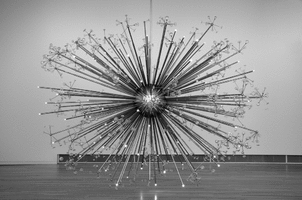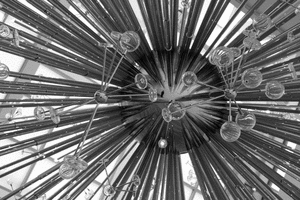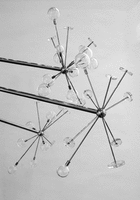

 .
.
Since September, 2004, I have collaborated with artist Josiah McElheny on the design of glass and metal sculptures that represent aspects of modern cosmology. One of these works, Island Universe, is currently on exhibit at the Los Angeles County Museum of Art (LACMA).
Although Josiah and I are not actively collaborating on any sculptures at present, we are constantly in conversation, and there is always the possibility that something new will emerge.
An End to Modernity appeared in the exhibition Part Object Part Sculpture at the Wexner Center in Autumn 2005. It then appeared at the Andrea Rosen Gallery in New York, and it is now in the collection of the Tate Modern gallery in London. The sculpture is 14 feet across and 12 feet high; it hangs so that the central sphere is at eye level. Here are a few photos:
The New York Times wrote a nice article about the sculpture, The Entire Universe on a Dimmer Switch, which appeared in May, 2006, during the Andrea Rosen exhibition.
An End to Modernity depicts, in idealized form, the history of the Universe from the Big Bang to the present day, with an emphasis on the evolution of cosmic structure. The second product of our collaboration, The Last Scattering Surface, zeroes in on two epochs: recombination, when the Universe went from opaque to transparent, and today, when the Universe is rich with galaxies and large scale structure. In this sculpture, the central sphere representing the last scattering surface is illuminated with lamps, and the brightnesses of these lamps are chosen based on the COBE map of the cosmic microwave background.
The Last Scattering Surface was first exhibited at the Donald Young Gallery in Chicago, and subsequently at the Rochester Art Center and the Henry Art Gallery at the University of Washington. It is now in the permanent collection of the Phoenix Art Museum. Here are a few photos (click for larger versions):
The third project, The End of the Dark Ages, is similar in concept and scale to An End to Modernity, but it "zooms in" on the early epochs, to the time when light from the first galaxies and quasars penetrated the depths of intergalactic space (a.k.a., the epoch of reionization). It was exhibited at the Andrea Rosen Gallery and is now a private collection. A nice photo and description appeared in The New York Times Magazine. Here are two more photos (click for larger versions):
Island Universe, is the most ambitious of all. Inspired by the multiverse scenario of eternal inflation (see, e.g., Andrei Linde's home page ), Island Universe consists of five sculptures that hang together in the gallery as a single work. Each individual bubble universe follows the same general structure as An End to Modernity, but the rules for generating structure are different in ways that might correspond to varying amounts of dark matter and dark energy or to varying levels of quantum fluctuations produced during inflation. Island Universe was commissioned and first exhibited by the White Cube Gallery in London (October/November 2008). Here are some photos (click for larger versions, and follow the White Cube Gallery link above for more):
It then moved to a radically different venue, the Palacio de Cristal of the Museo Nacional Centro de Arte Reina Sofia, in a park in central Madrid in Madrid (January-March 2009). Here are a few photos that Josiah took of the Madrid exhibition (click on the images for larger versions):
Island Universe has been exhibited subsequently at Boston's Institute for Contemporary Art, at the Moody Center for the Arts at Rice University, and at Stanford University's Cantor Center for the Arts. It is now in the collection of the Los Angeles County Museum of Art.
Here is my all-time favorite photo of Island Universe, taken at the Stanford exhibition by physicist Andrei Linde, whose ideas about cosmic inflation and multiverse cosmology were a primary inspiration for the work:
Following a long exhalation after Island Universe, Josiah and I found ourselves collaborating on a new project inspired by the fiber plugplates from the Sloan Digital Sky Survey. This work is titled A Study for The Center is Everywhere, which is rooted in its connections to Jorge Luis Borges, Blaise Pascal, and especially the 19th-century French socialist and political activist Auguste Blanqui, who devoted his time in prison to writing a cosmological treatise with startling speculations on the implications of an infinite universe. Here are a couple of images:
A Study for The Center is Everywhere is now in a private collection. There are some lovely quarter-size versions in various places, including my house!
Josiah and I have given joint talks about these projects at the Institute of Contemporary Arts in London, at the 66th annual meeting of the American Society for Aesthetics in Northampton, Massachusetts, at the Phoenix Art Museum, hosted by Future Arts Research at Arizona State University, at the Wexner Center for the Arts at Ohio State, and at the Cantor Center for the Arts at Stanford. You can also hear us in a short interview about Island Universe on the BBC science program Leading Edge.
From the Big Bang to the Multiverse: Translations in Space and Time describes the science behind An End to Modernity, The Last Scattering Surface, The End of the Dark Ages, and Island Universe. It appears in the book Josiah McElheny: A Prism, edited by Louise Neri and Josiah McElheny and published by Skira/Rizzoli (New York, 2010). This book has many wonderful images of and essays about Josiah's art, including all of the cosmological sculptures.
I wrote a Perspectives piece for New Scientist magazine about the collaboration and the sculptures; you can find it here. I also wrote a longer account of the collaboration for symposium Narrative, Science, and Performance, titled From the Big Bang to Island Universe: Anatomy of a Collaboration. I wrote a description of Center is Everywhere that you can find here or on arXiv.org.
For those who want something a little more technical, here is a more quantitative description, of An End to Modernity. If you are more hardcore, you can read the design notes for An End to Modernity or for The Last Scattering Surface.
There are two dazzling catalogs of the two Island Universe exhibitions, the London exhibition at White Cube Gallery and the Madrid exhibition at the Reina Sofia museum. Both of them have a wide range of remarkable texts, including a reprinting of a crucial chapter of Immanuel Kant's Universal History and Theory of the Heavens in which he hypothesizes that the nebulous elliptical smudges seen in telescopes are distant stellar systems analogous to the Milky Way. For An End to Modernity and its companion film Conceptual Drawings for a Chandelier (1965), the best source of images and essays is the Wexner Center catalog Josiah McElheny: Notes for a Sculpture and a Film.
NB: The images and texts linked to this page are copyrighted, so please do not copy them directly from here. If you want copyright information or permissions, you can contact me and I will direct you to the right place; for images, you can also contact the listed galleries directly.